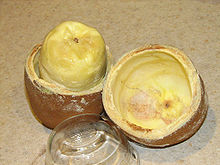| Cupuaçu | |
|---|---|

| |
| Scientific classification | |
| Kingdom: | Plantae |
| Clade: | Tracheophytes |
| Clade: | Angiosperms |
| Clade: | Eudicots |
| Clade: | Rosids |
| Order: | Malvales |
| Family: | Malvaceae |
| Genus: | Theobroma |
| Species: | T. grandiflorum
|
| Binomial name | |
| Theobroma grandiflorum | |
Theobroma grandiflorum, commonly known as cupuaçu, also spelled cupuassu, cupuazú, cupu assu, or copoazu, is a tropical rainforest tree related to cacao.[2] Native and common throughout the Amazon basin, it is naturally cultivated in the jungles of northern Brazil, with the largest production in Pará, Amazonas and Amapá, Colombia, Bolivia and Peru.[2] The pulp of the cupuaçu fruit is consumed throughout Central and South America, especially in the northern states of Brazil,[3] and is used to make ice creams, snack bars,[4] and other products.[5][6]
- ^ Fernandez, E.; Moraes, M.; Martinelli, G.; Colli-Silva, M. (2021). "Theobroma grandiflorum". IUCN Red List of Threatened Species. 2021: e.T191158664A191158666. doi:10.2305/IUCN.UK.2021-1.RLTS.T191158664A191158666.pt. Retrieved 19 November 2021.
- ^ a b Giacometti, DC (1994). "Cupuaçu". In Bermejo, J.E. Hernándo; León, J. (eds.). Neglected Crops: 1492 from a Different Perspective. Plant Production and Protection Series No. 26. Rome, Italy: FAO. pp. 205–209. ISBN 978-92-5-103217-6.
- ^ "Cupuaçu - the taste of the Amazon - Kew". kew.org. Retrieved 28 October 2018.
- ^ Balston, Catherine; Derry, Johanna (17 April 2014). "Cupuaçu: Brazil's new alternative to chocolate". The Guardian. Retrieved 28 October 2018.
- ^ Prazeres, Isadora Cordeiro dos; Domingues, Alessandra Ferraiolo Nogueira; Campos, Ana Paula Rocha; Carvalho, Ana Vânia (June 2017). "Elaboration and characterization of snack bars made with ingredients from the Amazon". Acta Amazonica. 47 (2): 103–110. doi:10.1590/1809-4392201602203.
- ^ "Brazil: Biodiversity for Food and Nutrition". b4fn.org. Retrieved 28 October 2018.
